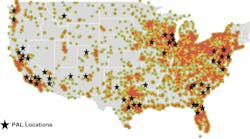As we put a new calendar on the wall, it's a good time to look ahead — not just through 2002 but also far down the highway, say to 2010. Such an exercise can help us think about where we want to be as individuals and as businesses, and whether there are better routes to get there.
Who will be in the driver's seat in 2010? The Bureau of Labor Statistics (BLS) has recently updated its projections to 2010 for employment and output by occupation and industry. BLS foresees little change in the growth rate of the overall labor force this decade compared to the 1990s. However, the age profile of the work force will have more of a barbell shape: As baby boomers near the end of their careers, their children enter the work force in large numbers.
The surge in new entrants is potentially good news for trucking, which has had a hard time attracting sufficient young drivers from the shrunken new-worker pool and booming economy of the late 1990s. As in the 1990s, the new entrants this decade will be increasingly from minority groups, especially Hispanics, Asians and women. Meanwhile, the aging boomers (the first of whom will be 64 in 2010) will begin retiring. Others will be seeking jobs that allow them to get home more often.
BLS foresees continued growth in demand for the industry it calls “trucking and courier services, except air.” Whereas BLS expects the average annual rate of change of output to slow from 3.5% in the 1990s to 3.3% this decade, the agency says this industry's “projected output growth of 4.2% … is one of the largest sources of output growth for the economy.”
According to BLS, “This industry is also expected to be one of the economy's largest sources of employment growth. Complementing the trucking industry, the warehouse and storage industry is expected to be one of the fastest employment and output gainers — increasing by 3.8% [per year]. Output for this industry is projected to grow at an aggressive 7.2%.”
“The effect of electronic commerce and expansion into logistical services such as computer inventory management and just-in-time shipping has been the driving force for growth in these industries “As manufacturers continue to improve supply,” BLS explains chain efficiencies by outsourcing their distribution needs, the trucking and warehousing industries will have more visible roles in the economy.”
In line with this rapid growth of the trucking industry, BLS projects that several freight-handling occupations will grow more quickly than the 15% overall expansion of the work force. Specifically, “packers and packagers; truck drivers, heavy and tractor trailers; and truck drivers, light and delivery services are projected to grow approximately 20%.”
Fuel will change by 2010. Both gasoline and diesel fuel will have been reformulated. The cost of refining those fuels may be a few cents higher than today, but the bigger question is whether the vehicles that burn those fuels will have higher purchase or operating costs. As the deadlines for introducing new engines and fuels approaches, each fleet will need to decide whether to be an “early adopter” or to hang onto existing trucks until the technologies are proven. Conversely, some fleets may want to try out hybrid fuels and powertrains now in case the standard choices available in 2010 are too problematic.
Finally, owners will need to adapt their individual investment or exit strategy to ever changing tax laws. Both income and estate taxes are scheduled to undergo several changes over the next eight years. The sudden reappearance of long-term deficits adds to the need for vigilance, since Congress may decide to delay some cuts or adopt offsetting increases.
The bottom line: Day-to-day operations require attention to drivers, vehicles, fuel and taxes. Having “2010 vision” means keeping the same elements in mind but taking a more far sighted view of the possibilities.


